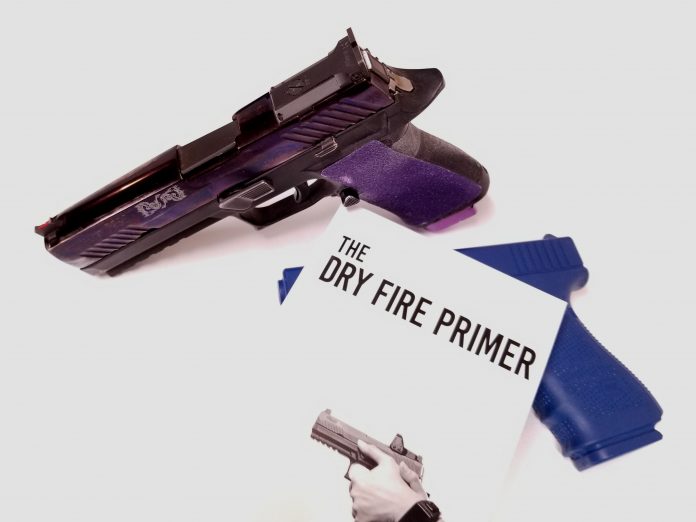
I’m not a Grand Master, it’s true. So why did I write a book about how to get better at shooting, and why should anyone read it?
Let’s start at the beginning, with the area of shooting I focused on – dry fire, also known as dry practice.
Dry fire is a hot idea among gun owners who want to become more proficient with their firearms. It’s recommended in many training classes and you can find articles and books about it all over the internet.
Since dry fire allows you to work on your shooting skills without firing a single round of ammunition, the advantages seem obvious. You don’t need to spend time and money going to the range, making it easier to fit into both your schedule and your budget.
The idea, at its most basic, is that you can take an unloaded gun and practice pulling the trigger while aimed at some sort of target. A common variation is to balance a coin on the front sight, with the goal being to be able to press the trigger without letting the coin drop.
At the other end of the spectrum, folks are practicing entire competition stages or defensive scenarios with empty guns. They’re running around, reloading, and sometimes using gadgets like SIRT pistols.
Both extremes are dry fire, and so is an awful lot of stuff in between. The question isn’t so much what dry fire is, but how much it can include and how it can be used best to help someone become a better shooter.
To answer that, I wrote The Dry Fire Primer. It’s a distillation of lessons I’ve learned on my journey from rather mediocre shooter to where I’m at today. While I continue to have a lot of room for improvement, I’ve become a consistently strong performer on the range even when I haven’t been able to get in much live fire practice.
In the process, I’ve had a lot of opportunity to think about what it takes to get from Point A to Point B. I’ve also picked the brains of experts across disciplines from simply dry fire to technical shooting performance to the all-important mental game. I haven’t limited myself to the firearms world either, looking at learning and practice techniques from other sports as well as areas like musical performance.
The culmination is a slim volume that talks about the whys and hows of dry fire. Rather than give you a series of drills that, frankly, wouldn’t be up to the standards of the excellent books already on the market, The Dry Fire Primer shows you what you need to know to get the most out of that material.
It tells you why you need dry fire in your life, and how you can fit it into your busy schedule. It explains how to set up, safely and effectively, for your practice sessions. It talks about the mysterious concept of par time, and how you can use it to make you a faster, more efficient shooter under pressure. It helps you understand what you should be paying attention to so that your dry fire is an effective learning tool. It points out what dry fire can accomplish – and what it can’t.
The Dry Fire Primer is aimed not only at newer shooters who are trying to establish their dry fire routines, but at more experienced shooters who are looking to revitalize their practice. Maybe you don’t know where or how to get started. Or maybe you’ve hit a plateau in your improvement, or you’re bored with dry fire. I include suggestions on all of these, drawn not just from my research, but also from my own experiences and that of my students.
Want to learn more? The electronic version of the book is available for Amazon Kindle, and printed copies are available both direct and from an increasing number of your favorite retailers.



